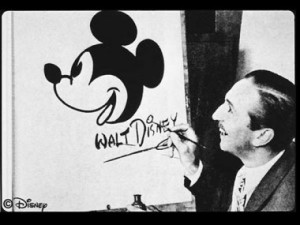Walt Disney the most influential studio (from an artistic as well as a commercial standpoint) in the history of animation is the Walt Disney Studio, which exploded onto the scene in 1928 with Mick Mouse in “Steamboat Willie” and continued to dominated the field to this very day. It is at Disney that we see the studio system’s best and most effects on the development of animation as an art form.
Without Disney’s streamlined organization of talent and creative collaboration the animated cartoon could never have advanced as rapidly or as beautifully as it has…yet, as at the Bray and Sullivan studios, in the process many of the men responsible for the studio’s achievements remain anonymous and forgotten. Had Disney animators Vladimir Tytla and Freddie Moore been alive during the renaissance their names might well have been numbered among Da Vici and Michelangelo. For all their accomplishments, however they remain totally eclipsed by the titanic figure of Walt Disney.
Walt Disney’s first important contribution to animation was to move his studio to Hollywood in 1923. Los Angeles had become the center of live-action film-making but the animation industry remained rooted in New York (with a few studios scattered throughout the Midwest, like Disney’s). Accompanying him on his move from Kansas City were Hugh Harman and Rudy Ishing, who Would eventually found the Warner Bros and MGM animation houses. These three studios were to become the leaders of the animation industry.Disney’s decision to move to California was a pivotal turning point in the development of animation as a business.
Disney Studio’s artistic attachments derived from a sort of symbiotic relationship between Walt and his employees. Like other studio heads, Walt received all the public attention and praise for the studio’s work, but unlike many of his fellow producers he was at least partly responsible for the studio’s accomplishments. He was certainly a cinematic visionary, and can be justly credited for introducing the latest innovations in sound and color.
Walt was the one who steered cartoons away from the “rubber hose” style of the silent era dubbed thus because of the way character moved without regard to anatomy, as if all their limbs were rubber hoses and encouraged his artists to develop a realistic, naturalist style of animation in the early 1930. He was the moving force behind such groundbreaking film as “Snow White and the Seven Dwarfs” (1937), the first full-length animated feature, and “Pinocchio” (1940), a film whose intricate levels of technical brilliance many animators feel has never been surpassed. But it was up to the studio artists to make Disney’s idea reality. It was Freddie Moore who led the movement towards realistic motion in cartoon with his re-definition of Mickey Mouse in such films as “The Band Concert” (1935). Disney features like “Lady and the Tramp”(1955) and “The Jungle book” (1967) could never have succeeded without the polished character animation of Ollie Johnston, Frank Thomas, Eric Larson, and others. Vladimir Tytla’s rendering of the demon Chernabog in the Night on Bald Mountain sequence of “Fantasia”(1940) might well be the greatest work of animation ever. These extraordinarily talented men, in alliance with the vision of their leader, accomplished what Winsor McCay had deemed impossible high art in a studio setting.
